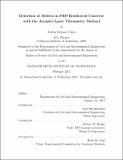Detection of defects in FRP-reinforced concrete with the acoustic-laser vibrometry method
Author(s)
Chen, Justin Gejune
DownloadFull printable version (8.292Mb)
Alternative title
Detection of defects in fiber-reinforced polymer-reinforced concrete with the acoustic-laser vibrometry method
Other Contributors
Massachusetts Institute of Technology. Department of Civil and Environmental Engineering.
Advisor
Oral Büyüköztürk and Robert W. Haupt.
Terms of use
Metadata
Show full item recordAbstract
Fiber-reinforced polymer (FRP) strengthening and retrofitting of concrete structural elements has become increasingly popular for civil infrastructure systems. When defects occur in FRP-reinforced concrete elements at the FRP-concrete interface, such as voids or delamination, FRP obscures the defect such that visual detection may not be possible. Most currently available non-destructive testing (NDT) methods rely on physical contact; an NDT method that is capable of remotely assessing damage would be greatly advantageous. A novel approach called the acoustic-laser vibrometry method which is capable of remote assessment of damage in FRP-reinforced concrete, is investigated in this thesis. It exploits the fact that areas where the FRP has debonded from concrete will vibrate excessively compared to intact material. In order to investigate this method, a laboratory system consisting of a commercial laser vibrometer system and conventional loudspeaker was used to perform tests with fabricated FRP-reinforced concrete specimens. The measurement results in the form of resonant frequencies were compared to those determined from theoretical and finite element defect models. With a series of measurements the vibrational mode shapes of defects and extent of the damage were imaged. The feasibility of the method was determined through a series of parametric studies, including sound pressure level (SPL), defect size, laser signal level, and angle of incidence. A preliminary Receiver Operating Characteristic (ROC) curve was determined for the method, and future work involving the acoustic-laser vibrometry method is proposed.
Description
Thesis (S.M.)--Massachusetts Institute of Technology, Dept. of Civil and Environmental Engineering, 2013. This electronic version was submitted by the student author. The certified thesis is available in the Institute Archives and Special Collections. Cataloged from student-submitted PDF version of thesis. Includes bibliographical references (p. 165-168).
Date issued
2013Department
Massachusetts Institute of Technology. Department of Civil and Environmental EngineeringPublisher
Massachusetts Institute of Technology
Keywords
Civil and Environmental Engineering.